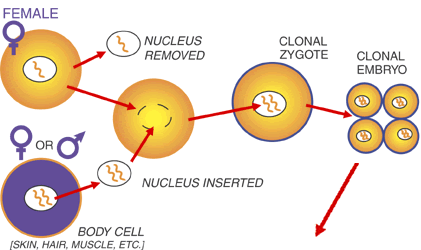Research cloning uses somatic cell nuclear transfer to produce a clonal embryo. Sometimes called "embryo cloning" or "therapeutic cloning," it would begin with the same procedure that would be used for reproductive cloning: the nucleus from a body cell is put into an egg from which the nucleus has been removed. The resulting entity is triggered by chemicals or electricity to begin developing into an embryo.

Instead of being implanted in a womb and brought to term as a cloned child, the embryo would be used for research purposes—for example, to generate embryonic stem cells.

Most scientists agree that research cloning for medical research is not needed as a source of embryonic stem cells—these can be obtained from embryos generated by in vitro fertilization. Rather, researchers have proposed that research cloning may turn out to be useful for producing "customized" embryonic stem cells that could generate compatible replacement tissues for individual patients. Replacement tissues generated in this way would presumably not be rejected by a patient's immune system, since their genetic make-up would be the same as that of the patient.
(Images courtesy of the Association of Reproductive Health Professionals)
More Information
![]() Analysis:
Examine the social, cultural, and economic landscape
Analysis:
Examine the social, cultural, and economic landscape
![]() Perspectives:
Explore various communities' concerns regarding human genetic
technologies
Perspectives:
Explore various communities' concerns regarding human genetic
technologies
![]() Policies:
Read about existing and potential regulations
Policies:
Read about existing and potential regulations
Date modified:











